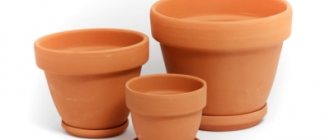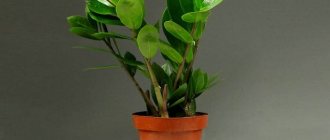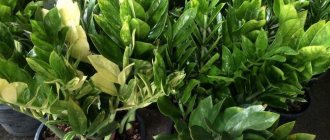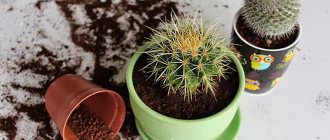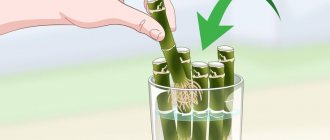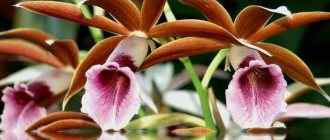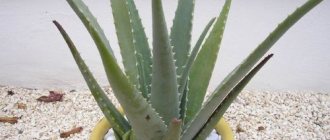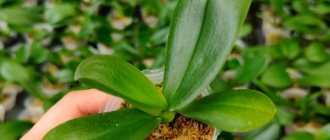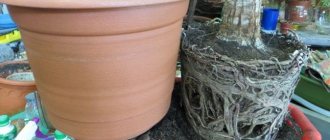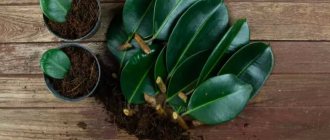Zamioculcas is popular among gardeners due to its friendly growth of dense green foliage and undemanding nature, but replanting can be a serious stumbling block.
A video on how to transplant zamioculcas at home will help you avoid mistakes and quickly master a complex but necessary procedure for the plant. The difficulty of replanting a crop that has arrived on window sills from Africa is that under the surface of the soil, Zamioculcas hides not only tubers, but also powerful, succulent rhizomes. Their damage during transshipment or division of the bush can cause long and painful acclimatization and root rotting.
In addition to caring for roots, the African guest is very demanding:
- to the timing of the transplant;
- soil composition;
- the size and even the material of the pot.
To ensure that, with proper care of zamioculcas, replanting at home does not lead to sad consequences for the plant and the grower, you need to prepare for this process in advance.
How to understand that Zamioculcas needs a transplant
Signs that Zamioculcas requires a transplant can easily be mistaken for signs of other problems:
- growth slowdown;
- yellowing and wilting of leaves;
- other signs of wilting.
All this in indoor flowers can also be a sign of the presence of pests, root rot and other diseases.
Zamioculcas has a well-developed root system. If the roots have taken over the entire area of the pot, the flower stops developing. At this time, he also begins to experience nutritional deficiencies, so he needs a transplant.
Repotting may be necessary if the drainage in the pot is insufficient. Excess moisture is harmful to the root system, so in this case replanting is necessary to improve drainage.
Important! It is believed that Zamioculcas is poisonous, so try to keep it away from children and pets.
After purchasing zamioculcas in a store, it is also advisable to plant it in another container.
And there are several reasons for this:
- a store pot is a temporary container, smaller in size than needed;
- unbalanced soil composition - you cannot be sure that it is nutritious enough;
- lack of drainage;
- The holes at the bottom of the container are too large.
What pot is needed for Zamioculcas
To choose the right pot model, you should follow several rules:
- It is important not to forget that the container for the plant must have drainage holes. Excess moisture will be removed through them.
- There should be a lot of holes at the bottom of the container. In order for the plant to consume the required level of water, it is necessary to avoid stagnation of liquid in the pot. To do this, it is best to choose a flowerpot with large holes at the bottom.
- The root system of the dollar tree consists of a tuber and long thickened roots, which, like the branches, grow in a vertical direction. Therefore, the pot should be high, but not too wide - a 3-5 cm margin in diameter is enough.
- It is not recommended to immediately take the container “for growth”, since this only slows down growth and spoils the quality of the soil.
Material
The material of the pot can be either plastic or clay. It must be remembered that damaged plastic products produce harmful substances, which can adversely affect the growth and health of the plant. Transplanting from a clay container is more difficult, since it is difficult to get the flower out of the pot, especially for inexperienced gardeners, and the root system is often damaged.
The difference between a plastic container is that it can be cut in order to get the roots intact.
Avoid purchasing a glass pot for Zamiocalcus. In such a container the soil will retain moisture for a long time. Do not forget that a favorable condition for the growth and development of this plant is dry, well-ventilated soil. Otherwise, due to excess moisture, the roots may be subject to disease and rot, which leads to the death of the plant.
Pots made from peat and coconut fiber are available for sale. The advantage of such models is that the soil is well ventilated, and moisture does not stagnate, which leads to drying out of the soil. Zamiocalcus finds it difficult to tolerate not only wet soil, but also drought, which is its paradoxical feature.
However, peat pots and coconut fiber pots are considered unsuitable for Zamioculcas, because contribute to the drying out of the soil, and although the plant can withstand drought, it may lose its attractiveness due to yellowing and dropping leaves.
Form
It is worth paying the necessary attention to choosing the shape of the flowerpot for planting zamioculcas, adhering to the following recommendations:
- the plant cannot be planted in a container with a narrow top, since the roots of the plant grow rapidly, and the narrow neck of the flowerpot will make it difficult to replant it next time;
- An excellent option for Zamioculcas would be to choose a low pot;
- It is preferable to purchase a container in which the bottom will be narrower than the outlet hole, which is associated with the growth of the stems of the indoor plant.
Pot size
When replanting, it is important to consider the size of the plant itself . A tree with massive, densely growing trunks should be transplanted into a pot with a wide top. If the plant has small tubers and thin shoots, then preference should be given to an elongated flowerpot with a diameter slightly larger than the previous one (about 1-1.5 cm).
When choosing a pot for zamiocalcus, you need to follow several rules.
- When replanting, the container should be slightly larger than the previous pot. If a flower is transplanted into a pot that is too large, the result will be a lack of growth of the above-ground part until the root system grows to cover the entire pot.
- You should also not choose a deep pot, since it holds more soil than the plant needs. In addition, a larger amount of water is required to shed the soil, which can cause waterlogging of the root system and its rotting.
- Consider the size of the plant. If Zamiocalcus has massive trunks that grow densely, it is better to purchase a wider pot. Mature plants have a well-developed root system, and the tubers are usually large. Young plants have thin shoots with small tubers and poorly developed rhizomes. For such a flower, it is better to choose a pot 1–2 cm wider than the diameter of the previous container.
- Choose a pot so that it can accommodate expanded clay in addition to the root system and soil; the container should not be too low and wide.
Is a planter suitable for a dollar tree?
A flowerpot is a decorative container without drainage holes, in which, as a rule, a flower pot is placed. It is impossible to plant zamioculcas directly in flower pots because such containers do not have a system for removing excess watering liquid, which has a negative effect on the plant.
Is it possible to plant in a larger or tall container?
Zamioculcas should not be planted in a container that is too large . If you transplant the plant into a pot with a large diameter, the above-ground part will not develop until the roots reach the walls and occupy the entire lower part of the container.
The height of the pot should also be optimal. A bowl that is too deep will contain much more soil than required. And moistening the soil in such a container will be problematic; a large amount of liquid will be required, which will cause putrefactive processes in the root system. A pot with insufficient depth will not accommodate the drainage layer necessary for the proper development of the tree.
You should not choose a container with a wide bottom and a narrow neck for planting. The green crown will be crowded, and the roots, on the contrary, will grow too much. It will be impossible to replant such a plant without breaking the container.
What color
When choosing a pot for zamioculcas, it is important to take into account the aesthetic component . In order for the planted plant to fit organically into the interior, it is recommended to choose a ceramic bowl in all shades of brown.
Important! According to Feng Shui, a dollar tree should be planted in a green or red pot, and a coin should be placed at the bottom.
When and how often can a plant be replanted?
If you replant zamioculcas annually, there will be no harm from it. In addition, you can easily notice the presence of pests or problems with the root system. Some gardeners recommend replanting this indoor flower every 2-3 years.
Zamioculcas can be replanted at any time of the year, but it is best to replant in late autumn. In summer, this can cause unnecessary stress on the plant, which is in the phase of active vegetation and reproduction. Early spring is also suitable for replanting.
Did you know? This plant is popularly called the “dollar tree.” It is believed that the appearance of each new leaf foretells a sudden monetary gain for the owner.
Description and characteristics of Zamioculcas
Zamioculcas belongs to the aroid family, which also includes spathiphyllums (female happiness), callas, anthuriums (male happiness). This succulent has many popular names - “eternal tree”, “dollar palm”, “celibacy flower”. The most popular is the dollar tree.
The homeland of Zamioculcas is East Africa. The exotic is accustomed to quite extreme conditions - rocky mountain slopes, where it is dry and sunny. This is probably why it is so unpretentious when grown in Russia.
Photo: The plant does not have a trunk; the leaves are formed from the rhizome.
The exotic plant does not have a trunk: the leaves are formed directly from the rhizome. Powerful roots can split the pot if the succulent suddenly becomes crowded. It is the rhizome that is one of the indicators of health. Its rotting and color change may signal a disease in the tropical beauty.
Necessary conditions for transplantation and cultivation
The plant grows well in diffused light. Therefore, a cloudy day with moderate air temperatures is suitable for transplantation.
For optimal growth and development after Zamioculcas transplantation, the following conditions are necessary:
- “dappled” lighting, without direct sunlight;
- almost any air humidity – from 40 to 70%;
- temperature +16…+24°C;
- well-drained soil;
- weekly watering, which is necessary if the top 4 cm of soil is dry.
Transplanting zamioculcas into a new pot step by step
In order to understand whether it is worth replanting Zamiocalcus, you need to evaluate the filling of the old pot with roots. If the plant has filled the entire space at the exit from the container, it is best to cut the plastic pot so as not to injure the roots, or use the method of dumping the flower out of the container.
Step-by-step flower transplantation:
- Prepare a flower pot larger in size than the previous one, pour a layer of drainage onto the bottom.
- Remove zamioculcas from the old pot using the transfer method.
- Check the roots, cut off rotten ones and separate young tubers. Sprinkle a damp layer of soil over the top, leaving room for roots.
- Plant vertically, placing the roots in the ground, sprinkle them.
- Compact the soil to conserve moisture and sprinkle with mulch of expanded clay chips or river pebbles.
- Put in place for its further growth.
Initially, do not place the seedling in direct sunlight. Gradually move to the sun. Observe the process of plant establishment. This is necessary because unexpected complications occur after transplantation.
Preparing for transplant
To successfully transplant zamioculcas, you will need to prepare:
- universal soil for replanting;
- a new pot that will be 5 cm wider in diameter than the previous one;
- drainage.
Bush indoor plants are also considered: Alocasia, Hoffmania and Hypocyrta.
Choosing a pot
It is necessary to plant zamioculcas at the same depth at which it grew in the “old” pot, so buy a container a little wider and larger than the previous one. The material can be plastic or ceramic; ceramic containers are more beautiful, but removing zamioculcas from such a pot is more difficult. Choose a pot taking into account your interior and ease of caring for the plant.
Soil and drainage preparation
The soil for zamioculcas should be loose and nutritious. You can buy universal soil for planting at a flower shop or prepare a soil mixture yourself.
To do this take:
- loam - part of the garden soil with some clay and sand content;
- perlite - a mass of volcanic origin used to increase soil looseness;
- compost - organic fertilizers that will increase the nutritional value of the soil;
- peat moss.
All components must be mixed in equal parts.
For a pot with a diameter of 12 cm you will need about 3 liters of each ingredient. Important! Peat moss is a natural antiseptic that can destroy putrefactive bacteria, which has a positive effect on the development of zamioculcas after transplantation.
Basic Rules
The difficulties of the procedure are mainly due to the particularly sensitive root system, so the standard method will not work in this case. The best option is transshipment while preserving the earthen clod.
It is necessary to replant a young plant into new soil annually, and an adult plant once every 2 years.
You should take into account a number of features of Zamioculcas and adhere to the rules regarding the choice of planting pots, soil composition and favorable time for planting.
Soil and drainage
In its natural habitat, Zamioculcas grows on sandy and rocky soils mixed with humus. At home, you can make your own soil mixture by combining the following components:
- vegetable humus - 1 part;
- peat - 1 part;
- turf - 3 parts;
- leaf soil - 2 parts;
- river sand - 1 part.
The resulting soil mixture is thoroughly mixed and supplemented with a small amount of wood ash or coal, which acts as a preventive and protective agent against diseases.
If it is not possible to prepare the soil, you can use a specialized substrate for cacti and succulents, diluted by 1/3 with coarse sand, perlite or vermiculite, which will improve the degree of soil aeration and its water permeability.
It is not worthwhile to increase the nutritional value of the soil excessively - an excess of microelements can provoke the spread of rot on the tubers of the crop.
To protect the flower as much as possible, a drainage layer is laid out in the container, the height of which must be at least 5 cm. River pebbles or expanded clay can be used as materials.
Choosing a pot
The size of the pot depends on the age of the plant
Preference is given to low, wide pots, which ensure more convenient removal of the earthen clod during the next replanting. Be sure to have drainage holes.
The ideal material is plastic pots, which, if necessary, can be cut with scissors so as not to injure the sensitive roots of the exotic plant.
Some gardeners believe that this option is not always successful - during the growth process, the underground part can deform or split the container. Therefore, it is recommended to replant in large clay pots that are not covered with glaze, which will ensure maximum oxygen flow inside and excess liquid outflow.
The optimal size should exceed the previous one by about 15-20% or be 5 cm wider in diameter relative to the root system.
If you choose a container that is too large, there is a chance that the crop will stop growing due to the fact that all its energy will be directed to filling the empty space. There is also a risk of systematic moisture stagnation, which negatively affects the health of the tree.
Deadlines
The optimal time for the procedure is winter and early spring. However, in the event of an emergency at another time, for example, in the summer in August or autumn, it is not necessary to adhere to this rule.
Step by step transplant guide
Instructions for transplanting Zamioculcas:
- Water the plant until water begins to flow from the pot into the tray.
- Place your hand on the soil and turn the container upside down, holding the earthen ball.
- Shake it up and down until the lump of earth slides out of the container.
- If that doesn’t work, press the neck of the pot several times (assuming it’s plastic); Once the soil leaves the edges, the plant will be easier to remove.
- If the container is more than 30 cm in diameter, carefully walk around the perimeter with a spatula to easily remove the earthen lump.
- Cut off any black, twisted or diseased roots with pruning shears.
- Unravel the tangled roots.
- Make 3-4 cuts along the sides of the root ball with a knife.
- Place drainage in the new pot; it can be anything: expanded clay, crushed stone, gravel, polystyrene foam, ceramic shards, charcoal.
- Place a small layer of damp soil mixture on it.
- Place the root food on top of a layer of moist soil.
- Make sure that the roots are not crushed when transplanting.
- Fill the area around the root ball with prepared soil mixture or all-purpose soil.
Important! Do not knead the soil before watering!
Water the plant so that the water begins to flow into the pan. Under the influence of water, the soil settles. Now all that remains is to add more soil to the pot, so as to level the surface.
Video: Zamioculcas transplant
Rules for planting and transplanting
Replanting for any plant is a very important moment. Choosing the right substrate and container is half the battle. You also need to skillfully handle the process itself. However, don’t be alarmed, there is nothing complicated about transplantation if you act on time and according to all the rules.
Selecting soil and pot
When selecting soil for planting or replanting zamioculcas, you should take into account its ability to accumulate water with its roots and the natural growing conditions. Therefore, the soil for the plant must meet the following requirements:
- Be very loose, so that after watering water can easily seep through the soil, and not overloaded with nutrients.
- Have good air permeability so that the roots do not lack oxygen.
- Have neutral acidity.
When purchasing soil in a store, you need to choose soils intended for succulents. But it is also advisable to add brick chips, vermiculite or drainage of the finest fraction as a leavening agent. Still, take the time and effort to prepare a suitable substrate yourself. Moreover, you don’t need to go to Africa to get its components; they can be easily found in a flower shop. You will need to mix in equal proportions:
Recent Entries
Lilac perennials that are beautiful, compact and do not crowd out other plants Why when buying seedlings you should not take the sellers’ word for it and how to determine the age of the plant using 3 signs Tomato seedlings have turned purple or whitish: why the color has changed and how to save the plants
- turf land;
- leaf soil;
- peat;
- coarse sand.
A good addition to the composition would be a handful of charcoal: it absorbs excess moisture and prevents the development of pathogenic fungi. Heavy soil containing clay is strictly prohibited. The water in it will stagnate, and the roots will lack oxygen. The result will be disastrous - Zamioculcas will die.
Be sure to disinfect the soil. You can do this in the oven or in the freezer. High and low temperatures are equally destructive for pests and pathogenic flora.
Choosing a pot is a task no less important than preparing the soil. Zamioculcas is a rather large plant, and its root system can greatly increase in size. Plastic containers are suitable only for young plants. For adult specimens, you need to choose stable ceramic pots. Drainage holes are a must!
The pot must be high so that the drainage layer can take up at least ¼ of the total volume. It is better to choose flowerpots that are narrower in shape, but with a wide top, so that when replanting it is more convenient to remove the plant. The dimensions of the new container should differ from the old one by several centimeters. Don't think that a too big pot is good. Only the underground part will develop to a large extent, and the green mass will only have to wait patiently for the roots to take over the space.
Choose a pot for Zamioculcas that is tall and has a wide top.
When is the best time to replant?
The most suitable time for transplantation is, of course, spring. But if you missed the moment, then you can postpone the process to the beginning of summer. A slow-growing flower is rarely replanted - once every 3-4 years, when the roots become crowded and the growth of the flower stops. Young plants need annual transshipment.
If you purchased zamioculcas in a store in the fall, then give it a couple of weeks to acclimatize and then transplant it into a new container. This is done for 2 reasons:
- As a rule, the plant is already cramped in transport pots. This can be determined by the deformation of the plastic container.
- The soil in which zamioculcas is purchased is not suitable for the plant. It is based on a lot of peat, which retains moisture, and this is of no use to the plant.
An autumn transplant will not cause any discomfort to Zamioculcas.
Step-by-step instructions for transplantation
- Fill the new pot a quarter full with drainage. Sprinkle some prepared substrate on top.
- We begin to carefully remove the zamioculcas from the old pot. This is sometimes very difficult to do due to the highly overgrown root system. To make the task easier, you can knead the plastic container with your hands. Then place the pot on its side, hold it by the bottom with one hand, and with the other try to grab all the leaves closer to the soil and gently pull. If the process went easily, good, but if the plant sits tightly in the pot, then there is nothing left to do but cut it.
If the roots have grown too much, it is best to cut the pot
- The most suitable method of transplantation is transshipment.
Zamioculcas is transplanted using the transshipment method
Thanks to this method, the roots remain intact and the plant quickly takes root.
- We place the extracted plant in the center in a new flowerpot and add the remaining soil to the sides, lightly pressing it with our hands.
- Make sure that the roots do not go deep!
Zamioculcas transplant - video
If you replanted in dry soil, you can water it a little, but be sure to drain the liquid that has accumulated in the pan. If the soil is wet, you can water only 2–3 days after transplanting.
A large specimen may need support at first. It is best to use a collapsible circular one to hold spreading leaves.
Some nuances of transplantation
- If you decide to inspect the roots of the purchased zamioculcas and free them from the transport soil, this can be done by soaking the roots in a basin of water. The peat substrate will become wet and easily come off the roots, then carefully rinse the roots in clean water.
- Carefully cut off the affected areas found with a sharp knife, sprinkle the wounds with crushed activated carbon and let the treated areas dry for a day. Do not water the planted plant for about a week. During this time, the roots must recover, using the moisture that has accumulated in the tubers.
Aftercare after transplant
The plant is extremely unpretentious and can withstand difficult conditions, including drought and low light levels. Zamioculcas grows well in a cool room.
Zamioculcas will need periodic watering and fertilization. It should be taken into account that after transplantation, it will take some time for the flower to acclimatize to new conditions - during this period, flower growth is not observed. This is normal.
Location
In moderate lighting, Zamioculcas develops better, so it does well in indirect light on eastern or western windows: where the sun's rays only reach periodically.
Watering
For good development, the flower prefers moderately moist soil. To preserve soil moisture, the soil in the pot can be mulched - this will also prevent compaction of the soil and improve the development of the root system.
When watering, you need to pour water until it begins to flow into the pan. At this point, watering is stopped, and the water is drained from the pan so as not to contribute to the development of pests. The frequency of watering depends on the drying of the soil: if the soil has dried to a depth of 4-5 cm, then watering is needed. In winter, the plant needs less watering than in summer.
Did you know? In Tanzania, zamioculcas juice is used to treat earaches, and its roots are used to treat ulcers.
Fertilizer application period
Zamioculcas is fed during the growing season: spring and summer. Taking into account the fact that the plant is transplanted into new soil, it is fed with a half dose of fertilizer to avoid an excess of mineral salts in the soil. This is just as harmful as their lack.
The fertilizer must contain nitrogen, phosphorus and potassium. It is advisable to purchase liquid fertilizers with an equal proportion of the above components.
Features of the flower that determine the requirements for the vessel
Zamioculcas or dollar tree is popular among gardeners not only for its attractive appearance, but also for its ability to improve the financial situation of its owner. An unpretentious plant from the eastern part of the African continent has been decorating apartments and offices for a long time. However, in order for the flower to develop correctly and bring benefits, it is necessary to choose the right container for growing, taking into account the following features of the ornamental tree :
- Zamioculcas has thick stems and a voluminous crown, so the pot for growing it must be quite heavy and stable.
- The root system of the plant develops at a fairly rapid pace to the detriment of the green top; the planting container must be of the optimal size so that both the lower and upper parts of the tree are formed correctly.
- You need to know what conditions Zamioculcas does not like. This is primarily high humidity, but it also cannot tolerate drought. The growing plate should allow air to pass through well, and not retain liquid inside the earthen ball, but also not immediately release it into the pan.
Important! Peat and coconut pots are not suitable for growing dollar trees. They maintain optimal air exchange with the external environment, but do not retain moisture, which often leads to drying out of the soil.
Possible problems of transplantation and cultivation
Signs that a plant has problems:
- lower leaves turn yellow – most likely, you are over-watering the zamioculcas;
- the tips of the leaves turn brown: the cause is dry air and low humidity - organize more frequent watering;
- leaves turn brown and fall off – waterlogging of the soil and the appearance of putrefactive bacteria on the roots.
The main problem that the plant cannot cope with on its own is excessive watering.
If the soil is wet all the time, this leads to rotting of the roots and death of the zamioculcas. To fix the problem, you will need to remove the root ball, inspect the roots and remove any dead or diseased parts, then treat the root system with a fungicide and transplant the plant into another pot with new soil. In the future, you need to ensure that watering is carried out correctly.
Considering the unpretentiousness of Zamioculcas, it will not be difficult for you to transplant and grow this beautiful plant. And it will thank you for your care with magnificent development and flowering.
How to choose the right container in a store?
When choosing a container for planting zamioculcas, you must be guided by the following rule: the pot must have a sufficient number of large drainage holes .
A lack of them will lead to stagnation of moisture and rotting of the roots, and an excess will lead to drying out of the soil. It is important to choose the right bowl material:
- Clay . It allows air to pass through well and is safe for the plant. The disadvantage is the inconvenience when replanting the plant; getting the roots of the plant without damaging them from the clay pot is very problematic.
- Plastic . Harmful substances contained in plastic can negatively affect the condition of the tree. In addition, as the root system grows, the container may become deformed or crack. But when replanting, this is an ideal option; the plastic container can be cut and the plant can be removed without touching the roots.
Important! Glass containers are not suitable for growing zamioculcas. Excess moisture will be retained in such a container, which will lead to rotting of the root system. The exception is glass containers with a large number of drainage holes.
Which one is needed to plant a young plant?
The choice of container for planting is also determined by the age and size of the plant. If the leaf is just taking root, then you should choose a pot with a narrow bottom and a wider top to quickly grow the crown.
Another important condition is that the depth is not too great , but sufficient to accommodate drainage. However, the size should be small. The best option is a container that can accommodate the root system with a three-centimeter margin around the perimeter for a soil layer. Choosing a large pot for a small plant can lead to a number of problems with its health and development.
Which one is better to replant an adult succulent?
As soon as the root mass of the zamioculcas reaches the walls of the pot, it must be transplanted into a larger bowl. It should be slightly larger in diameter than the previous one (no more than 2-3 cm).
When replanting, it is important to consider the size of the plant itself . A tree with massive, densely growing trunks should be transplanted into a pot with a wide top. If the plant has small tubers and thin shoots, then preference should be given to an elongated flowerpot with a diameter slightly larger than the previous one (about 1-1.5 cm).
When is the best time to replant?
The best time for replanting for both young and mature plants is spring; the most favorable months are March and April.
Experienced flower growers wait until the plant finishes flowering, and only then begin replanting, otherwise the plant will drop all its flowers.
Young plants are replanted annually, as their growth is intensive for up to 3 years. It is necessary for them not only to change the size of the container, but also the soil due to its depletion.
Mature specimens try not to be disturbed so often, especially since plant growth slows down with age, so they are replanted every 3-4 years.
If the moment is missed, the transplant can be done at the beginning of summer.
Some lovers of indoor plants believe that autumn replanting is possible without much discomfort for the flower, although experts consider this to be incorrect. During this period, the flower is preparing for a state of dormancy for the winter and all processes in the plant are inhibited, therefore, there will be no good survival rate.
Recommendations for caring for Zamioculcas
A florist who wants to grow a spectacular zamioculcas will need to care and propagate the plant competently, having studied as much useful information as possible.
A planted dollar tree will feel best if its pot is placed in a well-lit or somewhat shaded place in the apartment. The plant does not need generous watering, and therefore it is advisable to avoid excessively moistening the soil substrate. In summer, abundant irrigation of the soil is carried out once every 14 days, in winter - even less frequently.
The dollar tree responds gratefully to leaf feeding. For this purpose, spraying is carried out with fertilizers diluted in water. It is very important to ensure that the leaves and leaf plates are kept clean - they can be periodically cleaned of dust with a soft cloth.
It is also recommended to periodically place the flower under a warm shower with the provided protection of the soil from drops (film cover).
Reproduced and grown plants will certainly delight their owners with their beauty and unpretentiousness. The presence of a dollar tree (one or several) in the house will help create an atmosphere of comfort and contentment, and their contemplation will certainly bring pleasure to all family members.
Biological characteristics and care features
Zamioculcas is an evergreen herbaceous plant with thick tubers and fleshy, pointed leaves. With proper care at home, mature plants can bloom. The flower is shaped like a corncob and is hidden in the axils of the lower leaves. Because of its resemblance to a palm tree, it is called the emerald palm or the Zanzibar pearl.
Necessary factors for proper cultivation
| Indicators | Spring Summer | Autumn winter |
| Temperature | +21–29 оС | +18–20 °C, critical limit +15 °C |
| Humidity | Spraying, washing the leaves for a bright shine, good to put in the rain | Doesn't matter |
| Watering | Abundant, but not often. Avoid overflowing and stagnation of water in the pan, otherwise root rot and stem rot may occur. May lose leaves during dry periods | With soft water when the soil is completely dry, no more than 1-2 times a month. |
| Lighting | A bright place, the leaves will become smaller in the shade. In strong sun, leaf burns are possible, the light should be diffused | Bright indirect light as possible |
| Fertilizer | Fertilizers for cacti - once a month, do not overfeed | Not recommended |
However, even if all agrotechnical growing methods are followed, the plant may begin to “wither.” One of the reasons for this is the delay in replanting the dollar tree or its absence.
Pot material
As the Na-Zemle portal notes, peat and coconut pots are not suitable . Although they maintain optimal air exchange with the external environment, moisture is not retained. This, in turn, often leads to drying out of the soil - the plant also does not like drought.
Clay bowls allow air to pass through well and are safe for zamioculcas. Their only drawback is the inconvenience during replanting - the fact is that getting the roots of a plant out of a clay pot without damaging them is quite problematic.
When transplanting, the best option is a plastic container. You can cut it and remove the plant without touching the roots.
Glass containers are also not suitable for growing zamioculcas . Excess moisture will be retained in such a pot - this can lead to rotting of the root system. The exception is glass containers with a large number of drainage holes .
Transplant technology
It is necessary to replant Zamioculcas according to the instructions:
- The flower is carefully removed from the pot; if necessary, the latter is cut with a suitable tool or broken. There is no need to remove the soil; it is enough to slightly straighten the roots and cut off the unproductive ones. If such manipulations cannot be carried out, the earthen lump is delicately rolled over a horizontal surface.
- If the tree is large and has several tubers, it can be propagated by dividing the rhizome. To do this, the underground part must be divided into a certain number of components, keeping roots and branches with growth points on each, and transplanted into different containers.
- The bottom of the flowerpot is lined with drainage, the thickness of which depends on the dimensions of the pot. In this case, the layer should be at least 3-5 cm in height.
- Fill in a little soil, plant a seedling on top, and fill the remaining voids. The substrate is lightly compacted, leaving the top of the tubers above the surface.
- Moisturize. Mulch with expanded clay, small pebbles or sphagnum.
